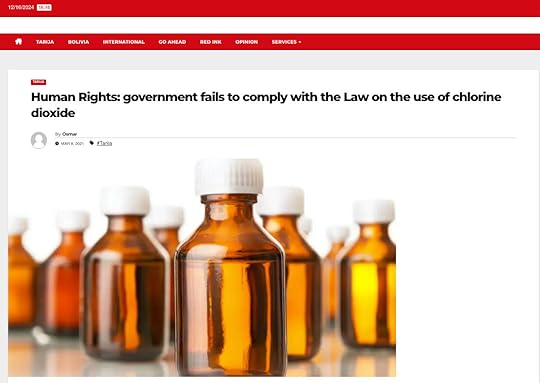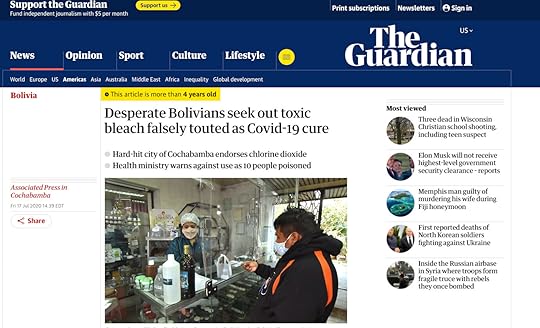Bolivia’s Use Of Chlorine Dioxide Led To Best Covid Outcomes In South America

Chlorine dioxide is a broad antimicrobial that is safe for ingestion. Bolivian MP’s passed a law supporting widespread use to combat Covid. This action led to a massive reduction in deaths.
In my first post in this series, I introduced the topic of chlorine dioxide as a therapeutic within its “political” context, not scientific. After a cursory introduction regarding its safety along with a few citations of its efficacy, I highlighted the regulatory, media, and judicial attacks against any who manufacture, recommend and/or sell chlorine dioxide for medicinal purposes via oral ingestion.
A key point I brought attention to is the bizarre prohibition against “oral ingestion” that “they” are trying to block at all costs (despite studies of both oral and IV administration showing little to no toxicity and the fact that there are numerous products already on the market for oral and/or dental applications).
In this post, I will share what I recently learned of what happened in Bolivia around chlorine dioxide. I think it is a story the world needs to hear. Again, these are the first of a series of posts on chlorine dioxide with later ones going more deeply into the data on safety and efficacy as well as treatment approaches for various conditions.
[…]
THE BOLIVIAN EXPERIENCE
The most notable event around chlorine dioxide in Bolivia was when a group of parliamentarians managed (somehow) to pass a law which allowed for the manufacture and distribution (and use) of chlorine dioxide in Bolivia on October 14, 2020.
[…]
To give what the Bolivians did some additional context, know that other South American countries also attempted such legislative efforts: a similar petition action was taken by Brazil’s chamber of deputies a year after Bolivia, but the law was quickly rescinded after the president changed from Bolsonaro (right) to Lula (left)/
[…]
And then in Peru, a group of parliamentarians passed a resolution to “study its use” in Covid (49 parliamentarians to be exact). However, as this newspaper article outlines, the fight over the resolution and over chlorine dioxide was both highly political and either willfully or negligently misinformed by the health authorities in opposition.
[…]
Also know that in Peru in June 2020, the Chief of the Covid Command in Ayacucho, a region of 100,000 people, was dismissed for treating patients with chlorine dioxide/
[…]
A similar pro-chlorine dioxide petition effort also took place in Paraguay’s Chamber of Deputies.
[…]
THE BOLIVIAN EXPERIENCELets get back to Bolivia now because that is where the “action” really happened around chlorine dioxide in South America.
After the law supporting the manufacture and use of chlorine dioxide was passed, the Bolivian Ministry of Health quickly issued a press release attacking the law and also the idea that chlorine dioxide was safe or that there was evidence it had anti-viral properties (which is astounding given it is likely the broadest and most effective viricide in use).
The Ministry tried to assert their authority by stating that the law was in opposition to its guidelines as a health authority and its responsibility to protect the health of the general population in Bolivia. Of course the “health of the Bolivian people” was their primary institutional concern! Who would ever openly question that?
[…]
Unsurprisingly, after Bolivia passed the law allowing for the manufacture and distribution of chlorine dioxide, newspapers (gleefully?) reported that this action directly defied the PAHO (a specialized health agency of the United Nations).
[…]
Thus the actual scientific and clinical data results of the Bolivian program are not accurately known (which I would argue is as intended) however, as you will see below, the epidemiological and anecdotal evidence is overwhelming (including reports of eradication of Covid in certain cities).
The below interview televised on “El Pais” is fascinating given that El Pais is one of the largest media outlets in Bolivia. Unlike the way the U.S media treated the topic of ivermectin, El Pais “presented both sides” by interviewing one clinical researcher who stated its safety and efficacy and then they interviewed a pharmacy regulator who stated there is insufficient evidence for chlorine dioxide and that it is dangerous to patients. The actually broadcast contrasting opinions instead of having someone simply call it a horse dewormer (or toxic bleach in this case) over and over again. Worth a watch (I added English subtitles, 6:16 total):
[…]
One statement from the clinician expert in chlorine dioxide jumped out:
“over 50,000 in Cochabamaba were using chlorine dioxide, and the lines to get treated were up to 500-800 people a day.”
I swear that was my initial vision/fantasy after discovering the potent efficacy of ivermectin in Covid – I first imagined a U.S national ivermectin distribution program! I had thought we could just “copy” the 40 year old WHO ivermectin distribution programs against parasitic diseases that had been conducted across Africa and other continents. Do you guys remember Fauci’s national ivermectin distribution program for Covid in the U.S.? I didn’t think so.
Anyway, let’s contrast some statements from the “regulator” and the “expert clinician:”
Chlorine Dioxide Expert Clinician:
So, when they threaten us with trials, they think they are going to shut us up. This is something that is not going to stop anymore. This is something that has already grown in such a way that it is impossible for any human power, no matter how much, I don’t know how no human power, no matter how many, what do I know, high level authorities want to stop it. They are not going to scare me with a process because I am not doing any harm. They have to prove to me that I have done any harm.
[…]
As I detailed in my first post, recall that the worlds “authorities” moved against chlorine dioxide even before their later coordinated attacks on HCQ and then ivermectin.
So, with all the fervor and national attention on chlorine dioxide in Bolivia, the powers that be hit back.. with lies (if you read the article below they mention 5 people being poisoned but no links or references to this statement were given, plus, even more absurdly, if you look at the sub-headline, they mention 10 people being “poisoned.” Isn’t it weird that a simple number was so different in the headline and the text of a major media newspaper?

Dr. Callisperis recently told me,
“The universities started to produce chlorine dioxide too. And then in some of the cities (Ed: all hyperlinks go to news reports showing evidence they were doing this) like Universidad Técnica de Oruro, Universidad Gabriel René Moreno, and Escuela Militar de Ingeniería in La Paz. and they started giving it out for free to all the people.”
The interview above was held with the Vice Rector of the Gabriel René Moreno University, Dr. Osvaldo Ulloa. He first admits that the university was producing it for their workers and students:
our University Social Security, directed by Dr. Méndez is justly using it, he has said so publicly and its effects are quite beneficial and that is very important because what we want is to collaborate.
Well, actually we have developed it and we have donated it, we can say, to the university insurance and the idea is to produce it to distribute it in a totally free way.
For that, of course, we need the support of the authorities such as the governor, the mayor’s office, so that they are the actual owners, right?
Those responsible for managing the first, second and third level hospitals in our capital. So, therefore, doctors i n some way depend on the Ministry of Health and of course also municipal governments and the government.
So, in order to use it in the treatment of these people who are hospitalized, we necessarily need their authorization. We know that there is a controversy at this moment, right?
From the Ministry of Health, which issued at a certain time a ban on consumption, since it claimed that it is a toxic product that we have done the research into. Doctors must control the supply of this product, even though we are aware that the product is not toxic, what is more, paradoxically I could tell you that if someone wants to commit suicide or, for example, has the idea of committing suicide and wants to commit suicide with chlorine dioxide, it is not you will be able to get it (sic: done) because it is not really toxic.
So rather with any other the drugs that are being used it would be much easier to do so. ŸOusand then that shows us that this product in the quantities and in the measurements of its components, as established and as indicated, could be very beneficial to combat the coronavirus and above all to give life expectancy to people, that is the objective that we pursue. We are aware that so far there is no definitive protocol that says this definitively cures the coronavirus (Ed: How can there be if authorities refuse to allow publication of the data or to do prospective research?)
All the medications that have had good results are still in research and that research is still ongoing.
Basically, if you listen to the whole interview, the Rector of the University states that they were having excellent results treating students, staff, and the community while pointing out that “the Ministry of Health calls it a toxic product.” Further he points out that in order to treat the patients in the hospitals, they “need the collaboration of the Ministry and municipal governments and federal government” (which they were not getting).
Interestingly, the head of Human Rights for Bolivia ended up intervening on the side of the chlorine dioxide program by going after the Ministry of Health for not drafting the regulations on the use of chlorine dioxide which the law demanded they do. This article below called out the “administration” for not obeying the law of the people. Imagine that?
On the issue of the University Rector calling out for collaboration with authorities to help the patients in hospitals, in the below article, the Mayor of San Juan De Chiquitos boldly proclaimed that they “emptied their ICU of 16 critical patients” after using chlorine dioxide and that “he was bringing the records of all 16 patients to La Paz” (Ed: like data makes a difference).
[…]
Via https://pierrekorymedicalmusings.com/p/bolivias-use-of-chlorine-dioxide
The Most Revolutionary Act
- Stuart Jeanne Bramhall's profile
- 11 followers



